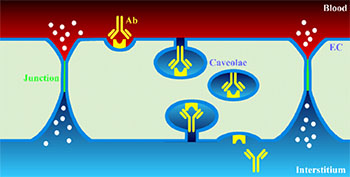


Posted December 18, 2014
Jan Schnitzer, MD, Proteogenomics Research Institute for Systems Medicine (PRISM), San Diego
 To be effective, anticancer drugs must pass through blood vessel walls in the body before they can reach and destroy tumor cells. Only a tiny portion of the drug dose ever reaches the inside of a tumor. One way to deal with the blood vessel barrier is to develop therapeutics that are smaller in size, making it easier for them to cross the blood vessel walls; however, these drugs tend to enter and harm both cancerous and normal tissues, resulting in unwanted and even lethal side-effects. This lack of selectivity in the drug's delivery and toxic effect has led scientists to try to create drugs engineered with tumor-specific identifiers, allowing them to target only cancer cells and spare normal cells. Yet these drugs despite being well-designed to interact only with tumor cells, are still impeded by blood vessel walls from reaching and killing their target cells.
To be effective, anticancer drugs must pass through blood vessel walls in the body before they can reach and destroy tumor cells. Only a tiny portion of the drug dose ever reaches the inside of a tumor. One way to deal with the blood vessel barrier is to develop therapeutics that are smaller in size, making it easier for them to cross the blood vessel walls; however, these drugs tend to enter and harm both cancerous and normal tissues, resulting in unwanted and even lethal side-effects. This lack of selectivity in the drug's delivery and toxic effect has led scientists to try to create drugs engineered with tumor-specific identifiers, allowing them to target only cancer cells and spare normal cells. Yet these drugs despite being well-designed to interact only with tumor cells, are still impeded by blood vessel walls from reaching and killing their target cells.
Dr. Jan Schnitzer, with funding from an FY10 Idea Development Award, sought to discover a "portal" to help targeted therapeutics specifically cross tumor blood vessel walls. His lab at the Proteogenomics Research Institute for Systems Medicine (PRISM) in San Diego made the key discovery that specialized cell membrane structures, called caveolae, function as pumps and display their own set of tumor-specific identifiers that can be targeted. Dr. Schnitzer's team generated an antibody that only recognizes a special tumor caveolae protein, called Annexin A1. Animal experiments demonstrated in vivo that the Annexin A1 antibody rapidly targeted tumor caveolae which pumped it across the blood vessel wall to penetrate prostate tumors. Toxic anti-cancer drugs were tethered to this antibody to deliver and concentrate their killing power only inside the prostate tumors which shrank rapidly after a single intravenous injection. The fact that this antibody delivery system was able to enhance therapeutic potency greater than 100-fold is quite significant, because this will allow for very low, nontoxic drug doses while still maintaining treatment effectiveness.
Dr. Schnitzer says, "This breakthrough provides new hope that drugs can be effective yet not toxic because now they can concentrate inside tumors to actually reach their intended targets -the tumor cells deep within the tumors." While this new therapeutic approach needs to be tested in human clinical trials, Dr. Schnitzer's discovery demonstrates a potential paradigm shift in the prostate cancer therapeutics which would increase not only patient survival, but also patient quality of life by decreasing harmful side effects.

Research Link:
Links:
Public and Technical Abstracts: Targeting Antibodies Into Prostate Tumors














